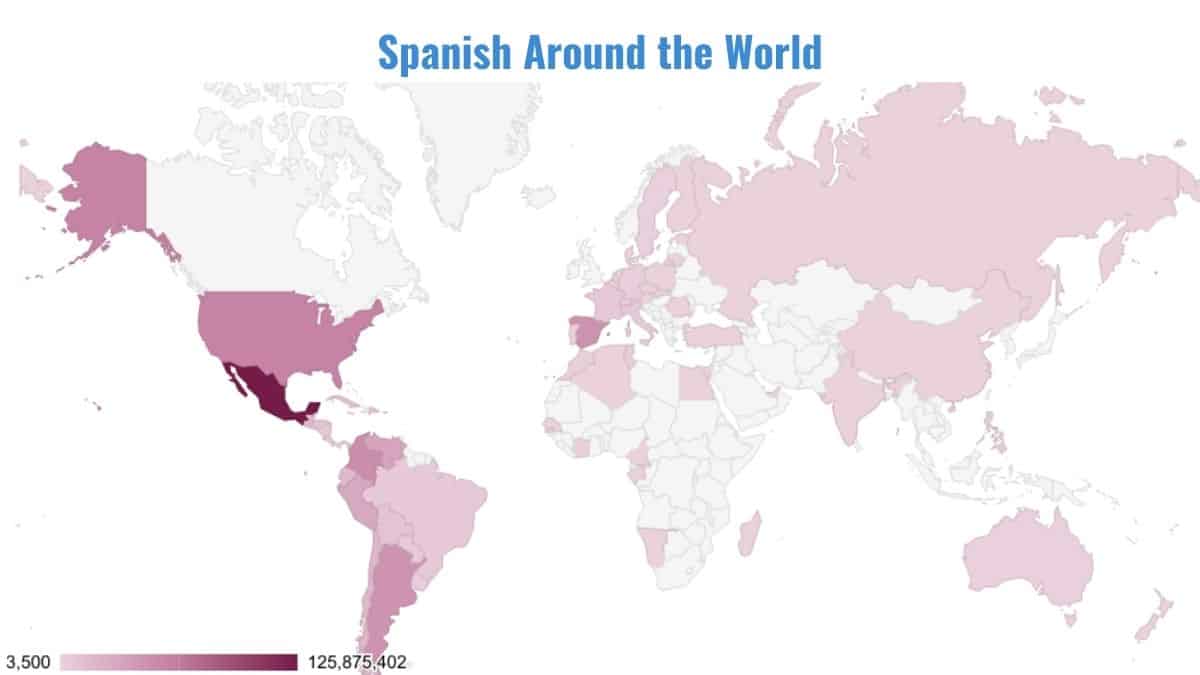Whether you’re researching, teaching, or learning Spanish, you may be interested in learning some cool facts about the Spanish language. For this reason, I’ve compiled a list of data and statistics that will give you some interesting insights into this language.
The information you’ll find throughout this article includes:
- Most Popular Languages in the World
- Spanish-Speaking Countries
- Spanish Dialects
- Hardest Part of Spanish
- Number of Words in the Spanish Language
- Most Common Types of Verbs
- Most Frequently Used Words
- Learning Spanish Online
- Miscellaneous Facts About Spanish
What Are the Most Popular Languages Spoken in the World?
According to Ethnologue, the most widely spoken language in the world are:
- English – 1,452,000,000
- Mandarin Chinese – 1,118,000,00
- Hindi – 602,000,000
- Spanish – 548,000,000
- French – 274,000,000
- Arabic – 273,900,000
- Bengali – 272,000,000
- Russian – 250,000,000
- Portuguese – 257,600,000
- Urdu – 231,000,000
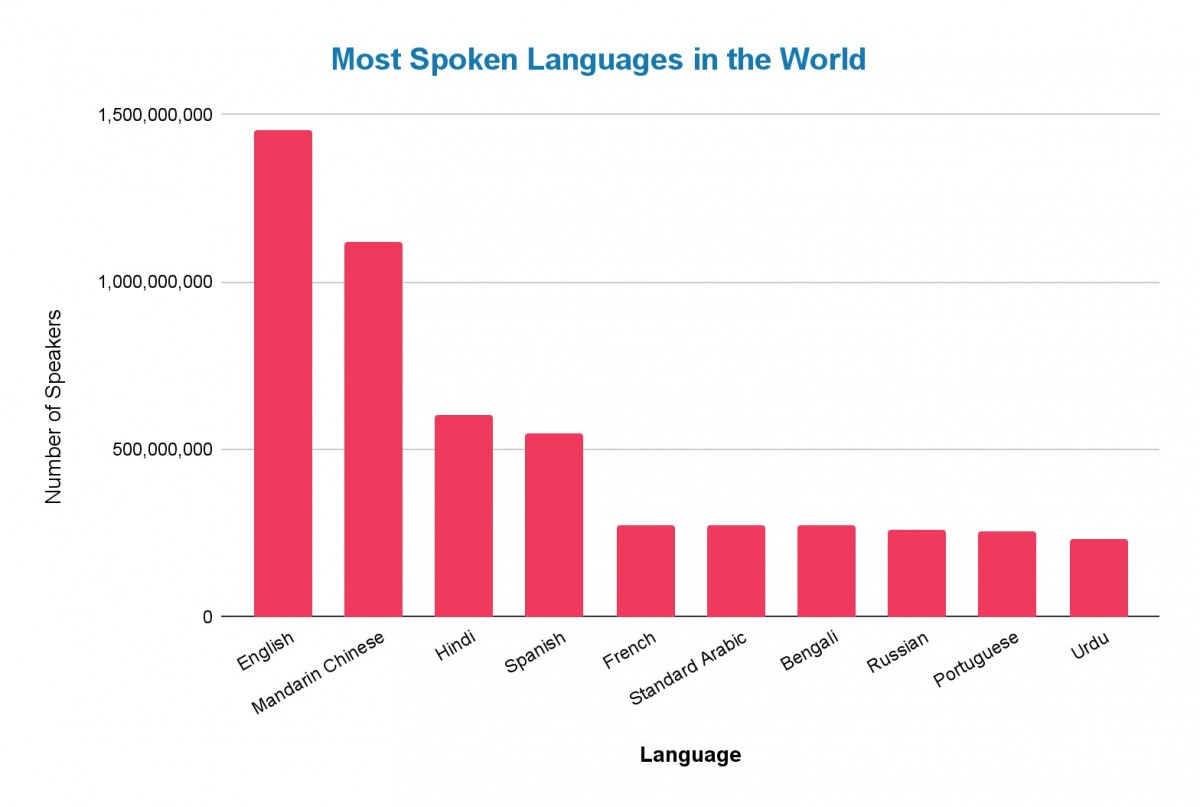
- Spanish is in the top 5 spoken languages, ranked #4 with 548 million speakers.
- Globally, there is 1 Spanish speaker for every 2.65 English speakers. In other words there are 165% more English speakers than Spanish speakers. It’s estimated that the Spanish speaking population will reach 111 million by 2060.
- With 1.118 billion speakers, Mandarin Chinese is the second most spoken language, which means that this language has 104.01% more speakers than Spanish.
- Hindi has 19% more speakers than Spanish.
- As the fourth most spoken language, Spanish has 100% more speakers than French and 100.07% more than Arabic speakers.
English and Mandarin Chinese are the two most spoken languages in the world. However, when it comes to native speakers, the numbers are quite different. In order to show this, we took into account the 4 biggest languages.
| Language | Total Number of Speakers | Native Speakers |
|---|---|---|
| English | 1,452,000,000 | 373,000,000 |
| Mandarin Chinese | 1,118,000,000 | 920,000,000 |
| Hindi | 602,000,000 | 344,000,000 |
| Spanish | 591,000,000 | 493,000,000 |
Source: Ethnologue. For Spanish, we took into account the data gathered by El Instituto Cervantes
After analyzing this data, we realized that:
- Out of the 591 million Spanish speakers worldwide, 83.42% are native Spanish speakers.
- Based on the number of native speakers, Spanish is the second biggest language.
- So out of the total 591 million Spanish speakers, 16.58% is formed by people who are learning Spanish or have a limited command of the language.
- English has the biggest percentage of second language speakers: 74.31%.
- But with almost 26% native speakers, English is smaller than Spanish and Mandarin Chinese based on the number of native speakers.
- This means that there are 3.48 times more people with English as a second language (or learning it) than Spanish.
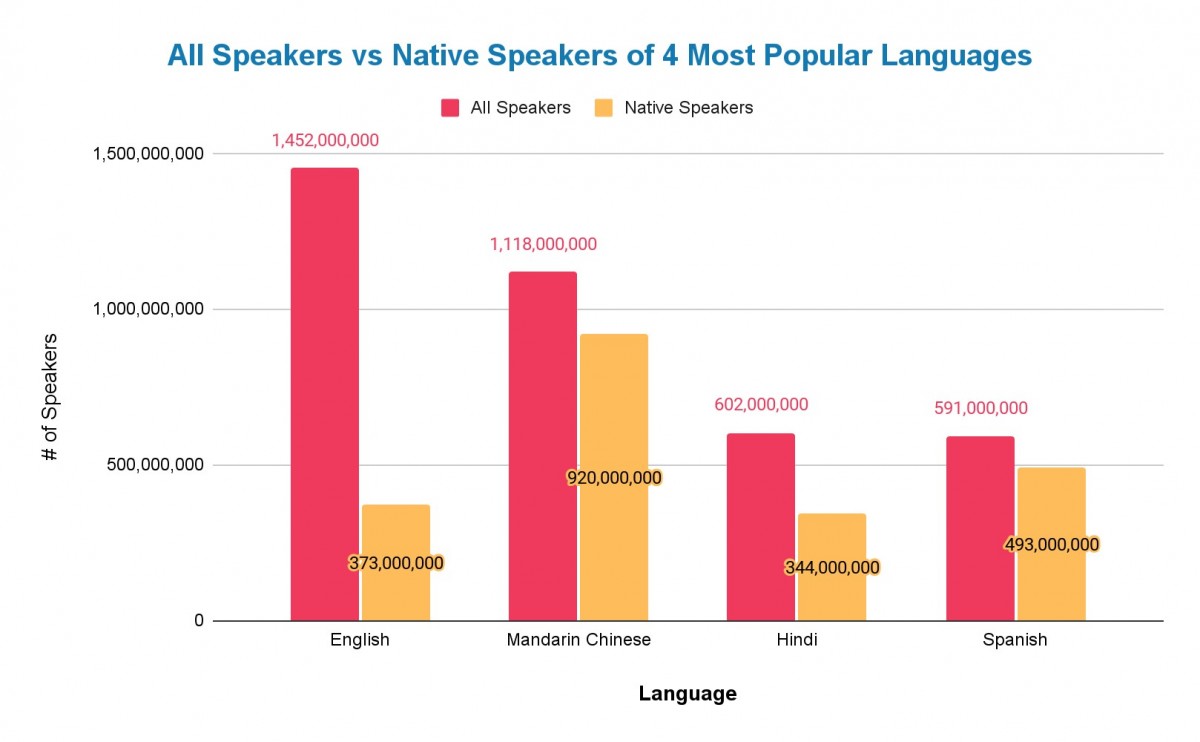
How Many Spanish-Speaking Countries Are There?
- Out of the 35 countries in the Americas, 21 of them have Spanish as their official language.
- This means that 57.14% of countries in America speak Spanish.
- 27.9% of speakers are from Mexico. As a result, Mexico is the largest Spanish-speaking country in the world.
- Colombia is the second-largest Spanish-speaking country.
- Mexico has close to 170% more Spanish speakers than Spain, 180% more than Argentina, and 152% more than Colombia.
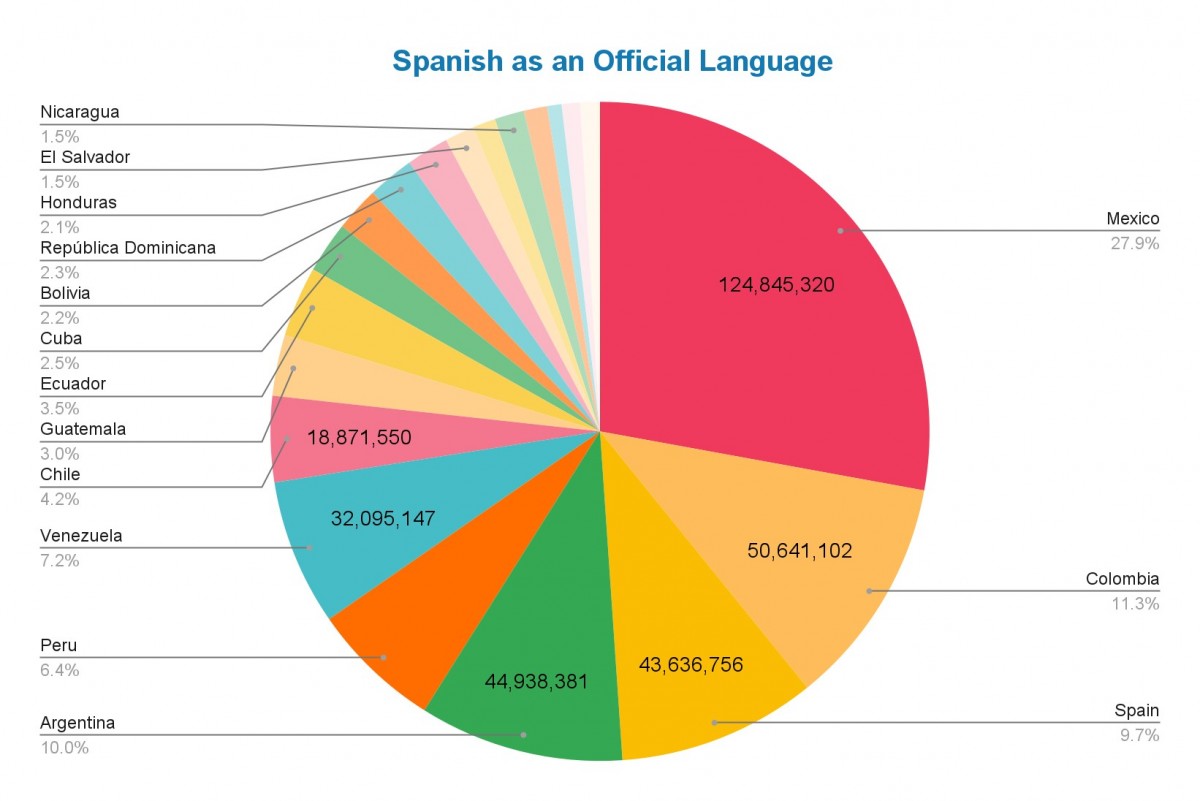
Where is Spanish a Second Language?
Even though most of the Spanish-speaking population is concentrated in Latin America, there are other countries that have Spanish speakers.
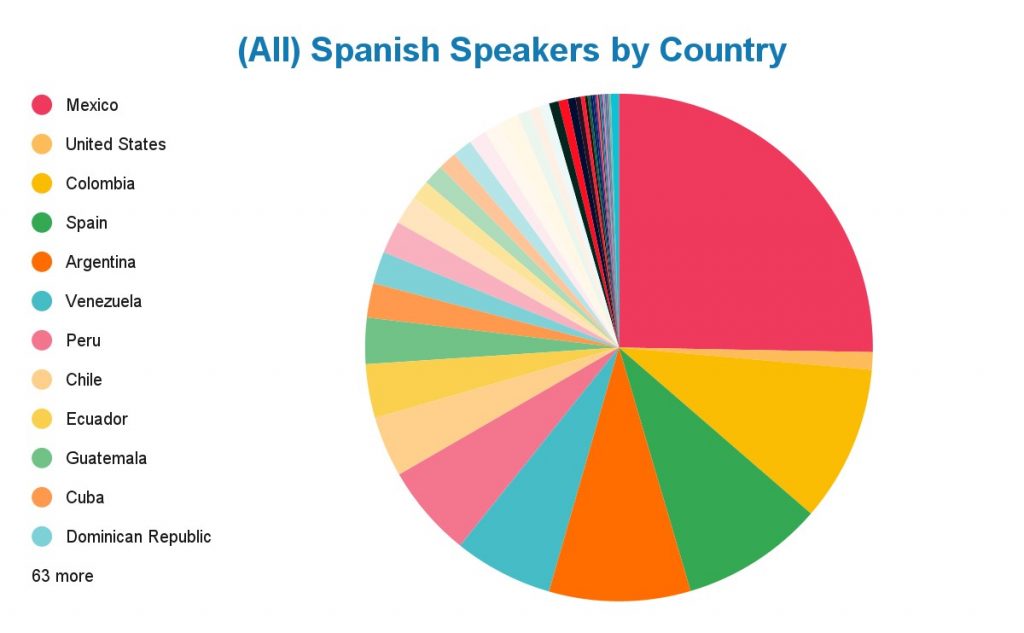
According to this Wiki data, here are some interesting facts about Spanish across the world:
- 40.30% of countries in the world have an observable population of Spanish speakers.
- This means that out of 194 countries in the world, 84 have Spanish speakers.
- Mexico represents 25.29% of the Spanish speakers in the world.
- Even though it’s not their official language, with 10.33%, the United States is ranked #2 in terms of total Spanish speakers.
- The United States has 22% more Spanish speakers than Spain and 12% more than Colombia.
- Mexico has 1.27x more Spanish speakers than the United States.
How Many Different Types of Spanish Are There?
Determining the specific number of Spanish variations is challenging since each country will present differences in vocabulary, grammar, and pronunciation. As a result, each country has its own particular way of using Spanish. However, due to their geographical location and their similarities, we could classify them in:
| Spanish Dialect | Country | Number of Speakers |
|---|---|---|
| Mexican Spanish | Mexico | 124,845,320 |
| Castilian Spanish | Spain | 43,636,756 |
| Rioplatense Spanish | Argentina, Uruguay | 48,367,770 |
| Andean Spanish | Peru, Ecuador, South of Colombia | 69,182,919 |
| Chilean Spanish | Chile | 18,871,550 |
| Caribbean Spanish | Cuba, Puerto Rico, Dominican Republic | 24,739,309 |
Take Note: Mexican Spanish has the largest number of speakers. As a result, it may be convenient for you to learn this dialect.
What’s the Hardest Part of Spanish
We gathered the answers of over 500 people that participated in online community polls related to the challenges they face when learning Spanish. In order to make these stats clearer, we classified their responses in:
- Grammar topics
- General challenges or problems when learning Spanish
Take Note: In these surveys, a respondent may have provided more than one answer.
So when it comes to Spanish grammar topics, we found the following trends.
- Respondents said that the most difficult Spanish topics are:
- Subjunctive
- Ser vs. Estar
- Past Tenses
- Por vs. Para
- Indirect Pronouns
- Masculine vs. Feminine
- Pronoun Se
- 27.2 % of people said that subjunctive is by far the most difficult topic for Spanish learners.
- With 15.7%, the second most difficult topic for Spanish learners is using Spanish Pronouns (Se, Direct & Indirect Pronouns).
- Even though ‘ser’ and ‘estar’ is widely known for being a complicated topic, 3.76x of Spanish learners considered subjunctive to be more complicated.
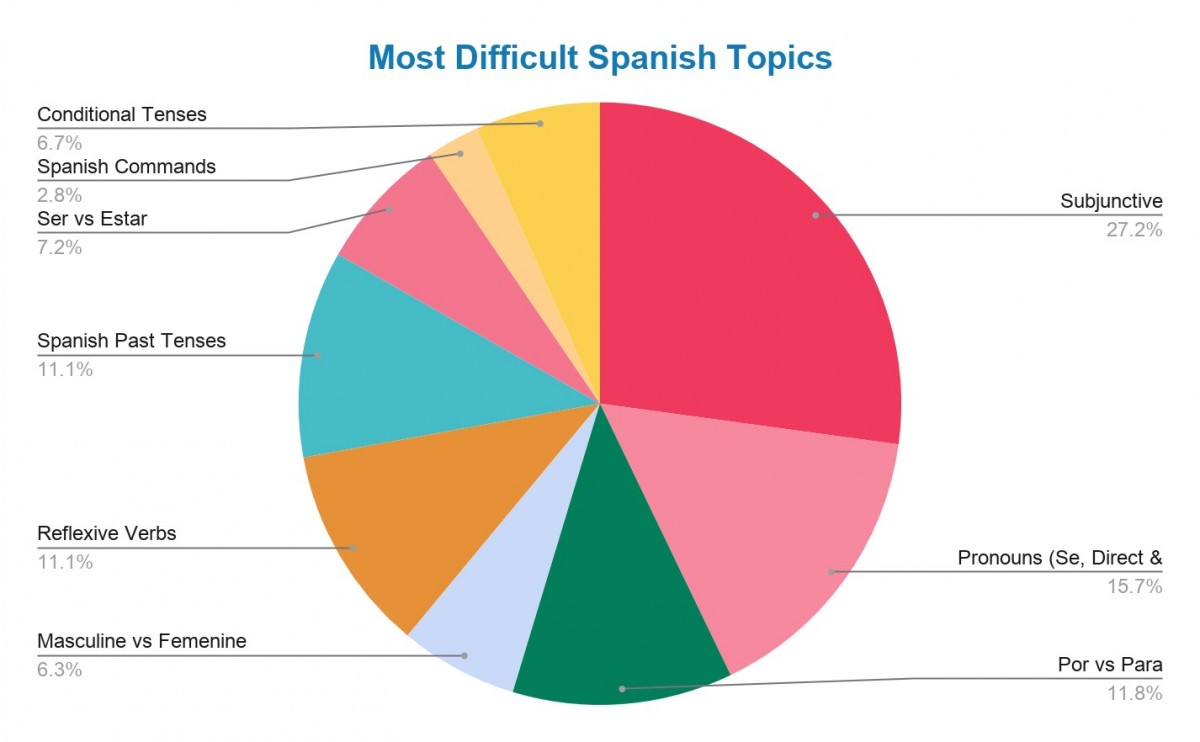
Biggest Challenges When Learning in Spanish
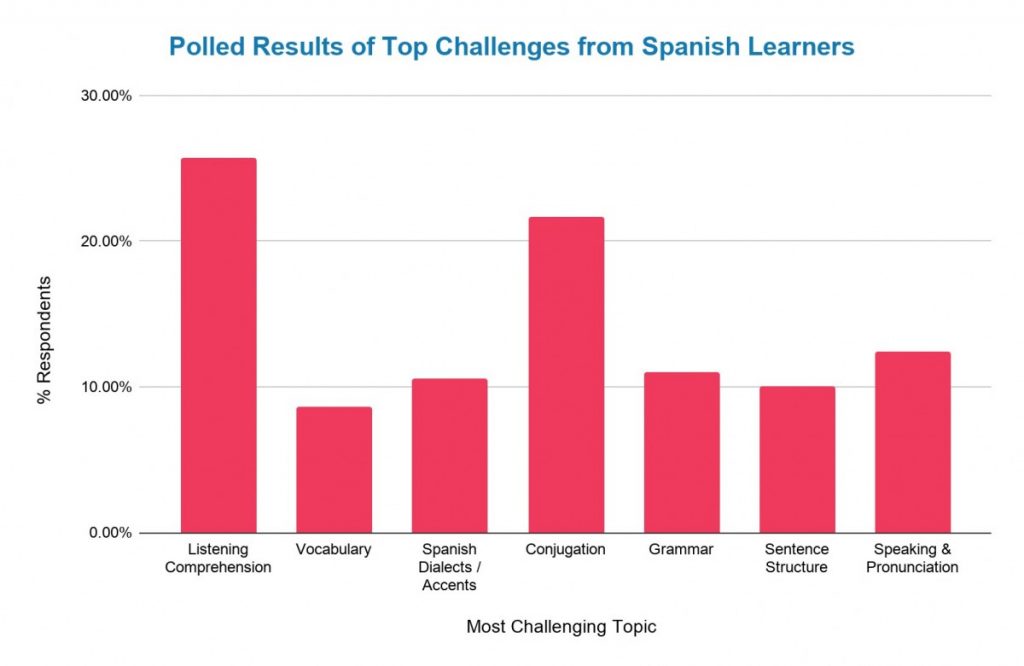
- 25.67% of people said that listening and understanding what native speakers say is the most challenging thing in Spanish. According to this study, Spanish speakers are in second place for producing more syllables per second. So perhaps this is why people learning Spanish struggle when listening to native speakers.
- 21.64% of Spanish learners said that dealing with verb conjugation is the hardest aspect of learning Spanish.
- Speaking and pronouncing was very difficult for over 13% of the respondents.
- When it comes to grammar, only 11.04 % of Spanish students considered it a big challenge.
- Building sentences and following a correct phrase structure was a problem for 10% of Spanish students.
- Only 8.66% of respondents said that vocabulary (not knowing a word and its multiple meanings) was difficult for them.
What’s the Most Difficult Accent in Spanish
In the previous table, Spanish learners mentioned that the different Spanish accents present a significant challenge for them. So we asked ourselves which of the different accents is considered the most difficult. We gathered responses from over 200 Spanish learners and native speakers, and this is what we found out:
- 30.42% of people said that the Chilean Spanish accent is the most difficult accent to understand.
- For 12.50% of respondents, Andalusian and Castilian Spanish are very difficult.
- 12.92% of people found the Dominican Republic accent the second most difficult one to understand.
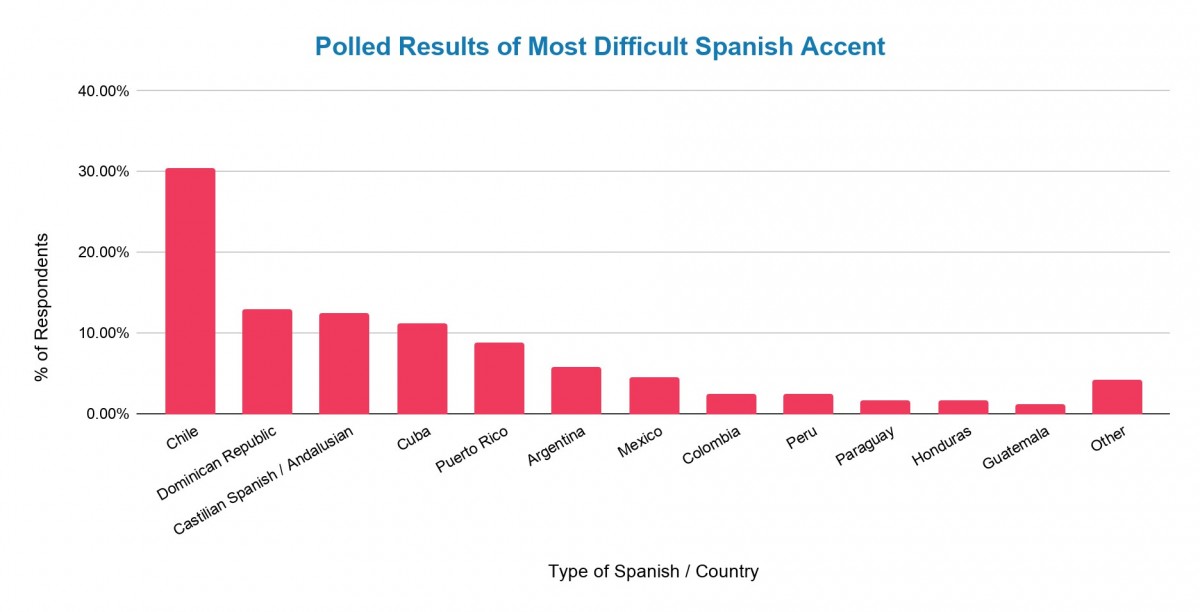
How Many Words Are There in the Spanish Language?
One of the most difficult aspects to tackle when learning Spanish is vocabulary: Spanish learners struggle because each Spanish speaking country has its own vocabulary. Here are some stats and data points about Spanish words:
- The Diccionario de Americanismos gathered 70,000 words that are common in Latin American countries, but not in Spain.
- El diccionario de la lengua española created by the Royal Spanish Academy has 93,111 individual terms. These words belong to standard Spanish.
- On average, 1 standard Spanish word has 2.1 meanings, while each informal term in Latin America has 1.71 definitions.
- Despite the difference in informal vocabulary, according to the newspaper El país, Spanish speakers share 90% of the vocabulary we know as standard Spanish. Standard Spanish consists of removing dialectal and informal expressions from the speech. As a result, Spanish speakers from different countries can understand each other.
Take Note: 1) El Diccionario de la Lengua Española contains standard Spanish words and some informal words (dialects) that have been accepted. Since they try to protect the language, not all words are accepted. 2) Diccionario de Americanismos contains words used in Latin American countries. The Royal Spanish Academy does not regulate these words, but they are accepted as part of informal speech in Latin American countries.
What Are The Most Common Verbs in Spanish?
According to the study performed by Jaime Suances Torres, there are 2252 standard and common verbs in Spanish. These verbs are classified as:
- Level 1: Verbs used by all speakers. It’s the most basic Spanish vocabulary.
- Level 1.5: Intermediate verbs that are between the thresholds of Levels 1 and 2.
- Level 2: Verbs used by people with average educational levels. They are still common but not as common as Level 1 and 1.5.
Based on this data, we found that:
- 377 verbs are part of the group classified as Level 1, which according to the Instituto de Verbología, are the most basic and common verbs among Spanish speakers
- 29.45% of these verbs are pronominal or reflexive verbs, meaning they need to work with a reflexive pronoun. In some instances, the presence of the reflexive will affect the meaning of this verb.
- Of these 2,252 verbs, 82.95% are verbs with –AR ending. 8.79% have -ER ending, and the last 8.26% have -IR ending.
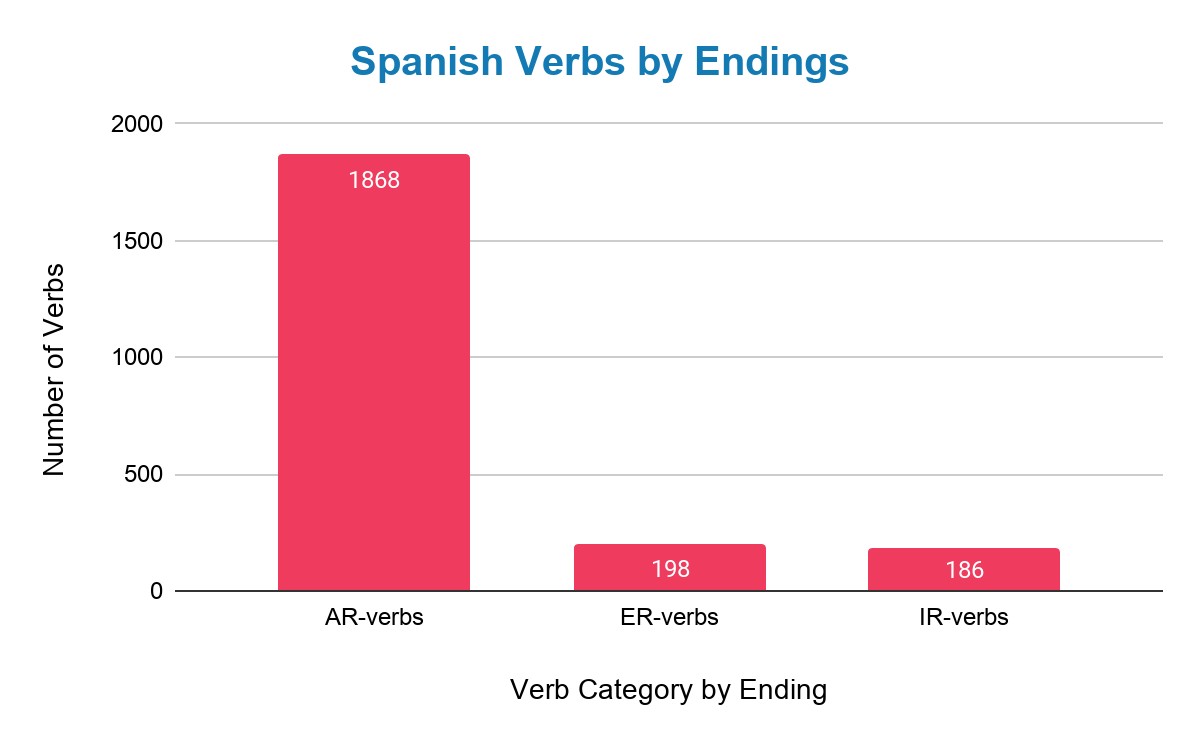
What Are the Most Common Words in Spanish?
Based on 68 million samples (books, magazines, newspapers, and transcriptions based on radio and tv shows), the Royal Spanish Academy created a corpus with the 10,000 most common words in Spanish.
After reviewing the data, we discovered some interesting findings regarding the usage of these words:
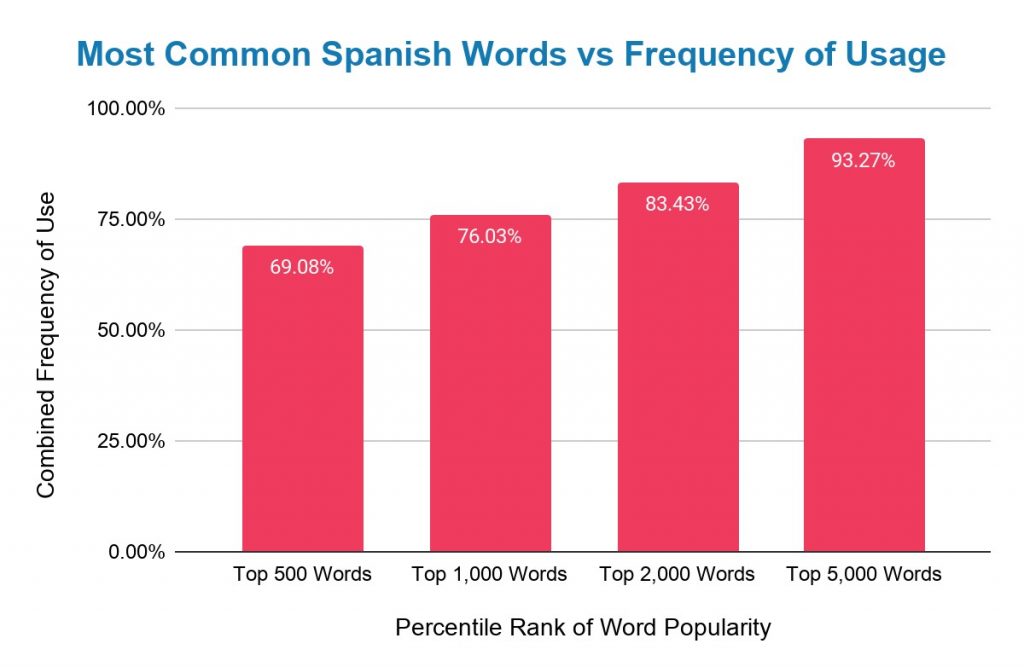
- The top 2,000 (20%) of the 10,000 most common words have a usage frequency of just over 83.4%, meaning the other 8,000 words were used less than 16.6% of the time.
- The top 5,000 (50%) of the 10,000 most common words have a usage frequency of just over 93.3%, meaning the bottom 5,000 words were used less than 6.7% of the time.
- In the top 2,000, we found that 52.95% of the words were nouns. In other words, out of those 2,000 words, 1,059 corresponds to nouns.
- Based on the same data, adjectives were used 12.65% of the time, and adverbs only 4.40%.
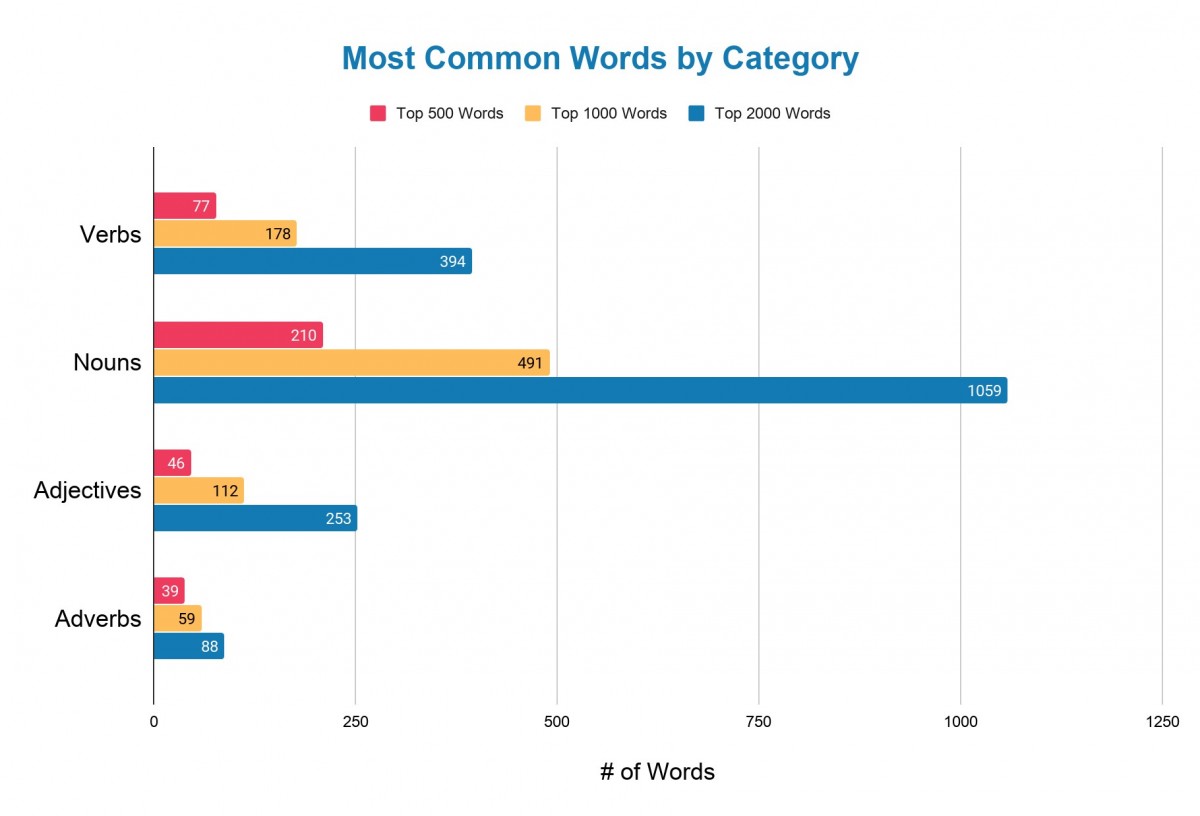
- Out of the 10,000 most common Spanish words, 2,621 were verbs. And when measured in terms of frequency of use, it was found that they represent 19.70% of the frequency of usage.
- Based on the corpus, the following are the top 10 conjugated verbs most frequently used:
- Ha – Haber
- Son – Ser
- Fue – Ir
- Había – Haber
- Era – Ser
- Han – Haber
- Hay – Haber
- Puede – Poder
- Tiene – Tener
- Hace – Hacer
- Funnily enough, these top 10 verbs are also part of the verbs of Level 1 (the most basic Spanish verbs) from El Instituto de Verbología, which supports the findings that they are the most frequently used verbs.
Conjugating verbs was one of the most challenging topics for Spanish students. As a result, we wanted to know which tenses and moods were more frequently used in this corpus. The trends show that:
- With 59.1% of frequency, indicative is the most common Spanish mood.
- When it comes to tenses and verbal forms, infinitive verbs represented 22.2% of the verbs collected by the Royal Spanish Academy.
The corpus registered that 5.2% of the most common verbs were used in the subjunctive form.
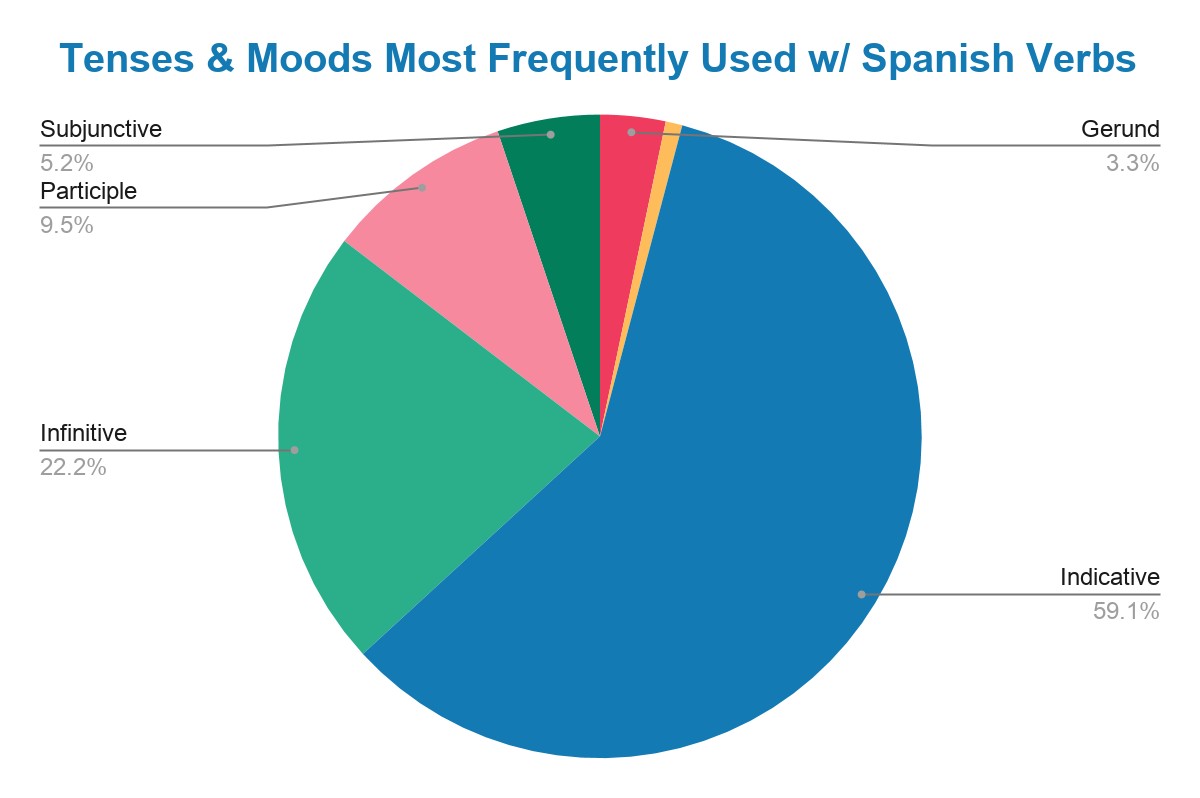
What are the most common pronouns used in Spanish?
- In the 10,000 most common words collected by the Royal Spanish Academy, we found 95 pronouns.
- The top 10 pronouns were used 63% of the time.
- According to the data compiled in this corpus, with 26.28% of frequency, ‘se’ is the most common pronoun in Spanish.
- Unlike English, in Spanish, we don’t need to use personal pronouns all the time. To prove it, we found that yo and él (both personal pronouns) have a frequency of 2.22% and 1.84%, respectively.
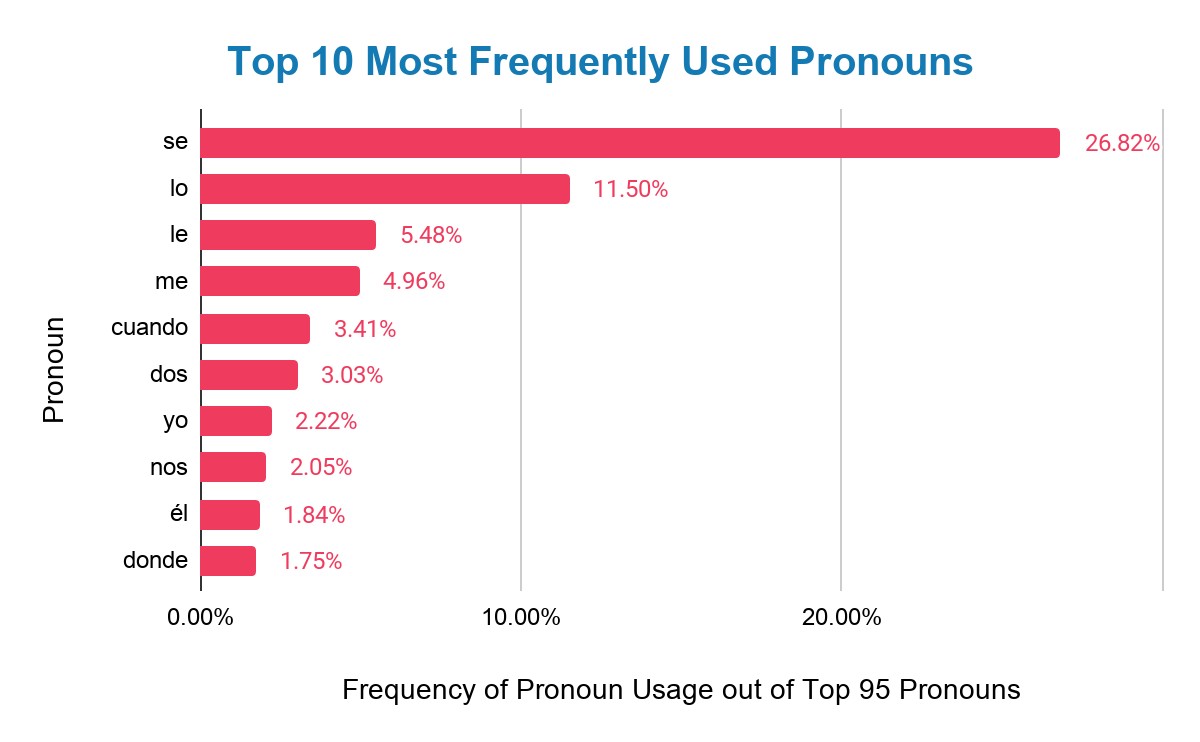
Learning Spanish Online
Spanish speakers, teachers, and learners alike may find it interesting to know which verb conjugations are most commonly searched for online. We collected data that showed the most searched queries and phrases following the format of “[verb] conjugation” for both searches occurring monthly in the U.S. and worldwide.
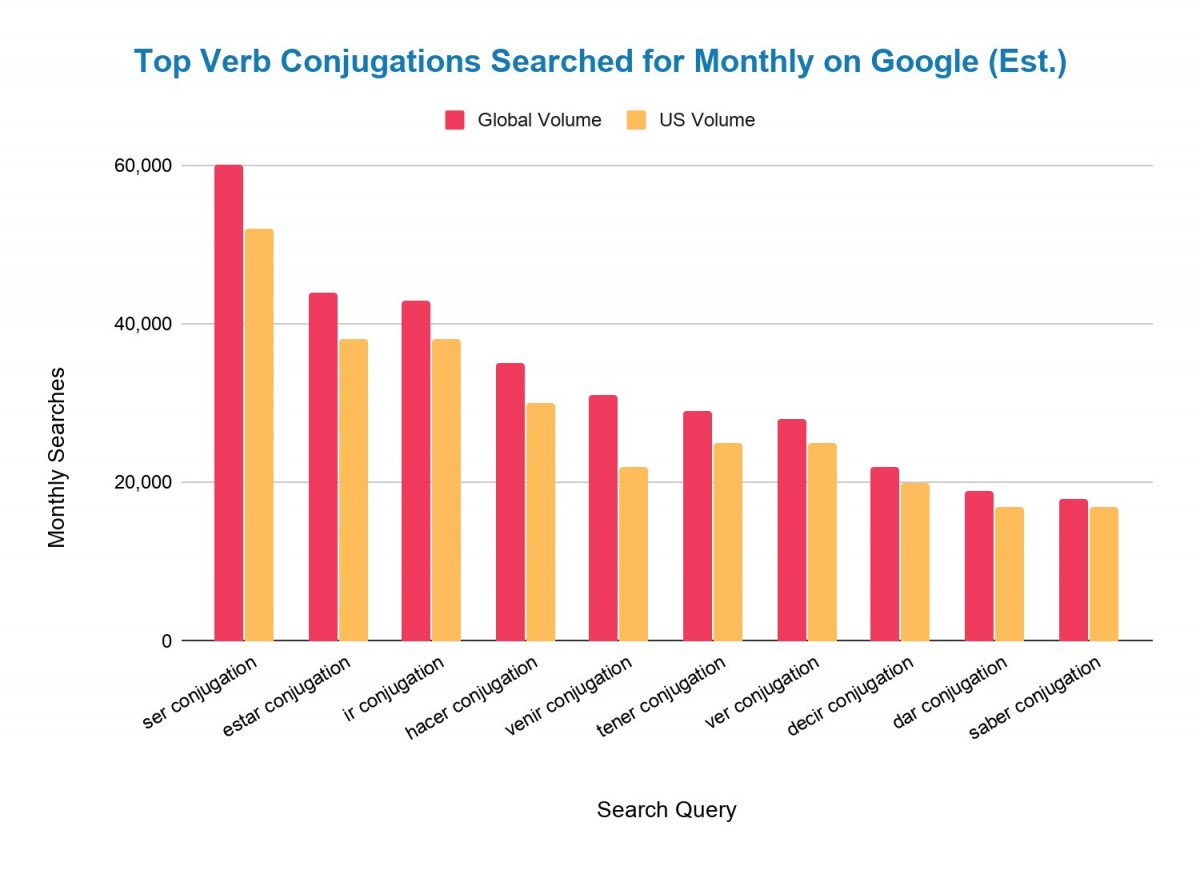
- The highest search of this type was “ser conjugation” with an estimated 60,000 monthly searches globally and 52,000 in the U.S.
- The 10th most popular was “saber conjugation” with 18,000 and 17,000 monthly searches globally and in the U.S., respectively.
- The combined estimated monthly search volume for these top 10 was 329,000 and 284,000 globally and in the U.S. respectively.
- Interestingly, all 10 of these verbs that are most commonly searched for are not only among the most popular and frequently used but also irregular.
We collected data that showed the most searched search phrases for “____ in spanish” for searches performed monthly in the U.S.
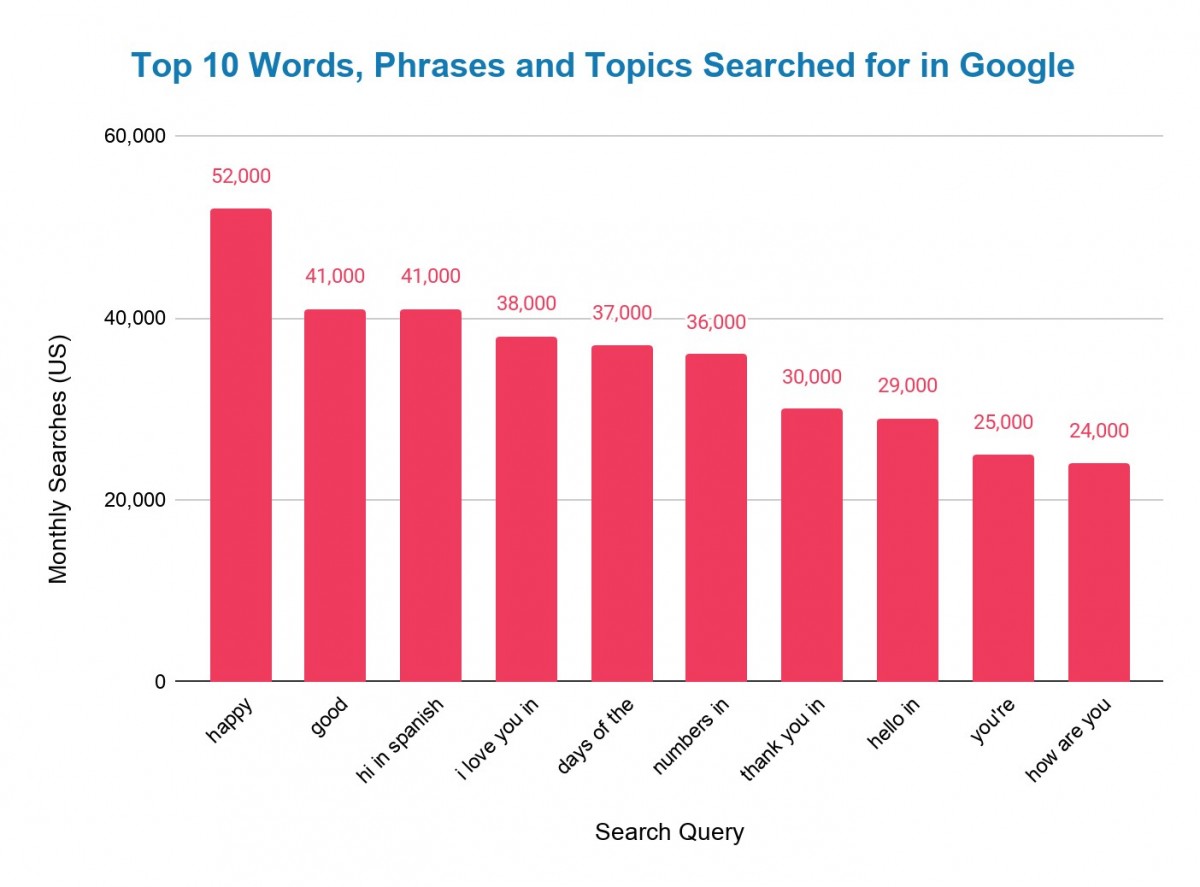
- The most widely searched query was “happy birthday in spanish” with approximately 52,000 monthly searches.
- “Good morning in spanish” ranked #2 with 41,000 monthly searches.
- #10, with 24,000 monthly searches, was “how are you in spanish“.
- These top 10 combined make up over an estimated 350,000 monthly searches and 4.2 million searches annually.
- Fun fact, only 1 curse word made it into the top 15.
Miscellaneous Facts About Spanish
- The Royal Spanish Academy gathers 17 Spanish tenses. However, Spanish speakers only use 14 tenses to communicate in their daily life situations.
- Español is the word that we use to refer to the Spanish language. On the other hand, Castellano refers to the Spanish dialect spoken in Spain.
- The Royal Spanish Academy establishes that the current Spanish alphabet has 27 letters. However, before 1994 our alphabet used to have 29 letters. This is because the phonemes ch and ll were considered letters back then.
- ‘Electroencefalografista’ is the longest word registered in a Spanish dictionary.
- The New American Economy found that jobs listing Spanish as a desired skill increased 150%.
Origins of Spanish
- Arabic has contributed more than 1043 words to the Spanish language. Some examples of common Arabic words adopted into Spanish include, but are not limited to:
| Spanish | English |
|---|---|
| Almohada | Pillow |
| Alfombra | Carpet |
| Aljibe | Cistern |
| Alberca | Pool |
| Azúcar | Sugar |
| Jarabe | Syrup |
| Ojalá | Hopefully |
- Many Spanish words that start with ‘al’ have Arabic origin.
- The first Spanish Grammar was published in 1492 by Antonio de Nebrija. In fact, this was the first printed book that studied a romance language.
- Mexican Spanish is highly influenced by Nahuatl, the most important Mexican native language. In fact, experts estimate that Mexican Spanish is formed of 4000 Nahuatl words.
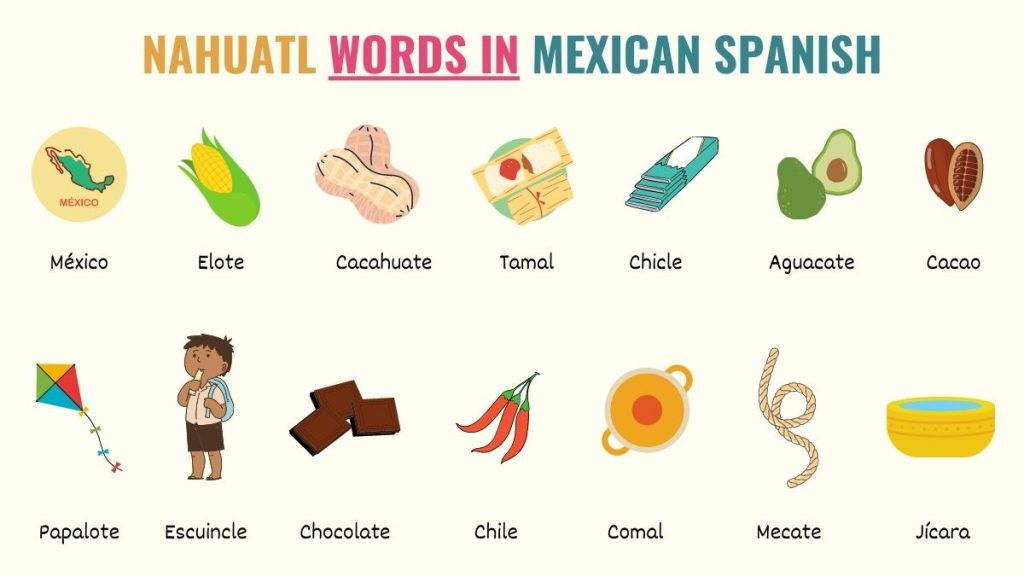
Wrapping Up
On top of giving you a break from grammar and vocabulary, the purpose of these Spanish facts and statistics was to show the Spanish language in numbers; whether you’re a student, a native speaker, or researching the language. Additionally, this information will help you identify the topics and elements Spanish learners and students need to pay more attention to. As you may have noticed, if you’re struggling with something in Spanish, you’re not alone 🙂

